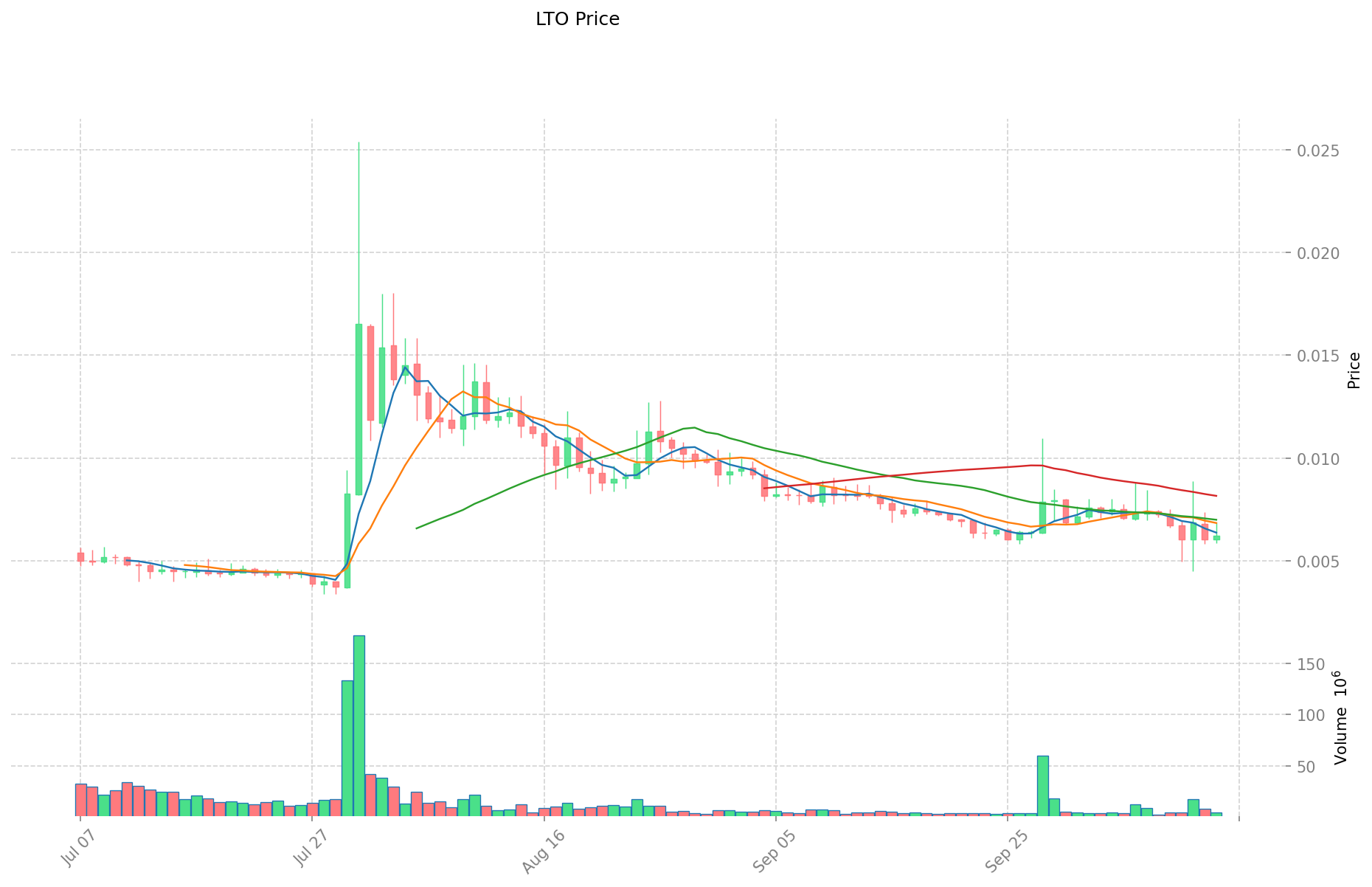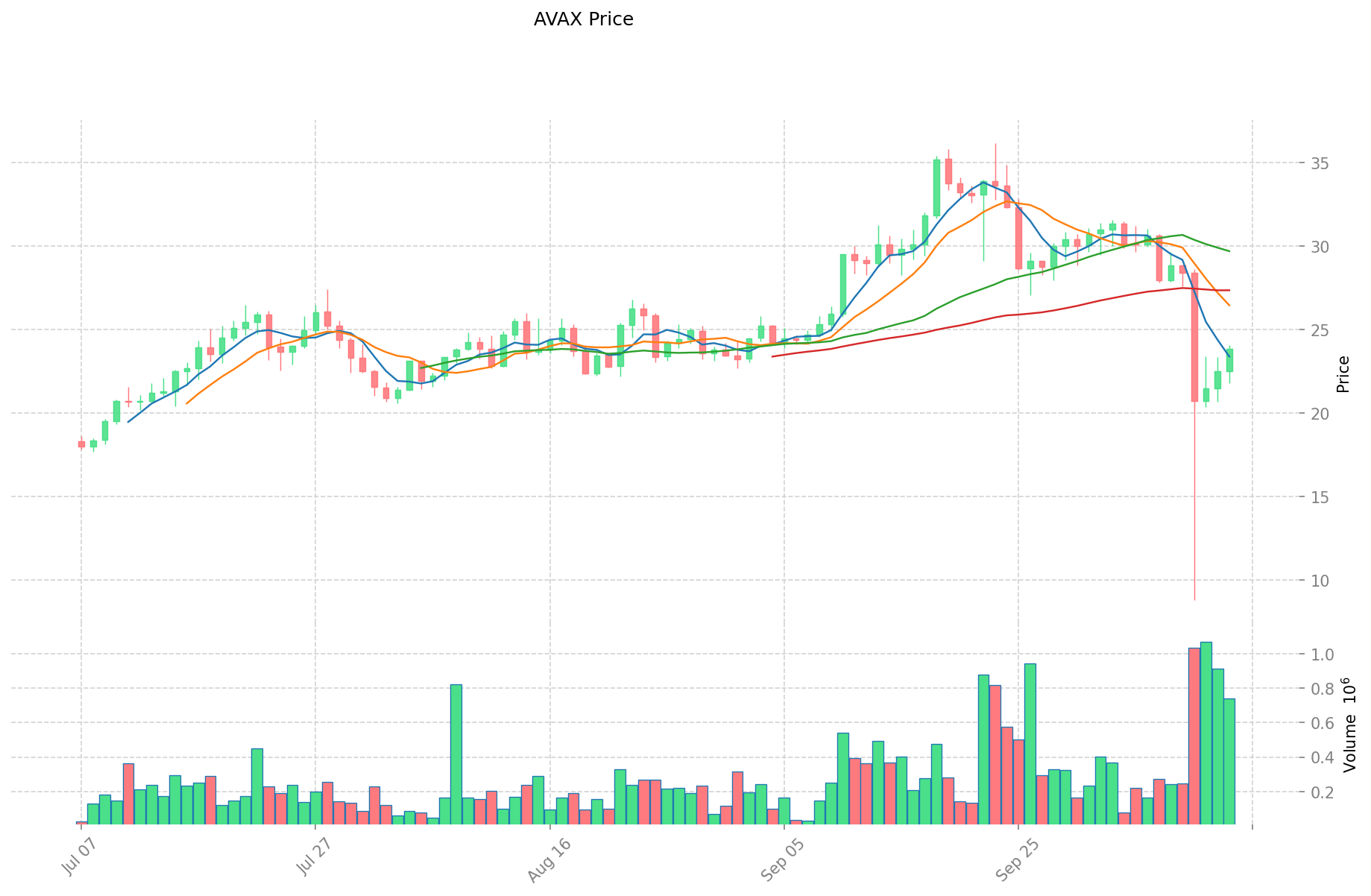LTO vs AVAX: Comparing Blockchain Solutions for Enterprise and DeFi Applications
Introduction: LTO vs AVAX Investment Comparison
In the cryptocurrency market, LTO Network vs Avalanche has always been a topic that investors can't avoid. The two not only have significant differences in market cap ranking, application scenarios, and price performance, but also represent different positioning of crypto assets.
LTO Network (LTO): Since its launch in 2014, it has gained market recognition for its enterprise-to-enterprise functionality and distributed workflow applications.
Avalanche (AVAX): Since its inception in 2020, it has been hailed as a platform for launching decentralized applications and interoperable blockchains, becoming one of the cryptocurrencies with high global trading volume and market capitalization.
This article will comprehensively analyze the investment value comparison between LTO and AVAX, focusing on historical price trends, supply mechanisms, institutional adoption, technological ecosystems, and future predictions, and attempt to answer the question that investors care most about:
"Which is the better buy right now?"
I. Price History Comparison and Current Market Status
LTO (Coin A) and AVAX (Coin B) Historical Price Trends
- 2021: AVAX reached its all-time high of $144.96 on November 21, 2021, likely due to increased adoption and market bullishness.
- 2020: LTO hit its all-time low of $0.0032098 on July 4, 2025, possibly due to market-wide bearish trends or project-specific challenges.
- Comparative analysis: In the recent market cycle, LTO dropped from its peak of $0.901021 to a low of $0.0032098, while AVAX has shown more resilience, currently trading at $23.83, significantly above its all-time low of $2.8.
Current Market Situation (2025-10-14)
- LTO current price: $0.006217
- AVAX current price: $23.83
- 24-hour trading volume: $27,126.43 (LTO) vs $16,540,762.31 (AVAX)
- Market Sentiment Index (Fear & Greed Index): 38 (Fear)
Click to view real-time prices:
- View LTO current price Market Price
- View AVAX current price Market Price


II. Key Factors Affecting Investment Value of LTO vs AVAX
Supply Mechanism Comparison (Tokenomics)
- LTO: Fixed maximum supply of 500 million tokens with deflationary model through token burning
- AVAX: Capped supply of 720 million tokens with deflationary mechanism through transaction fee burning
- 📌 Historical pattern: Deflationary models typically support price appreciation during bull markets, with AVAX showing stronger historical price performance due to its ecosystem growth and higher adoption rate.
Institutional Adoption and Market Applications
- Institutional holdings: AVAX has gained more institutional traction with investments from major venture capital firms and integration with institutional platforms
- Enterprise adoption: AVAX leads with cross-chain interoperability solutions and enterprise blockchain applications, while LTO focuses more on B2B blockchain solutions in specific sectors
- Regulatory attitudes: Both tokens face varied regulatory approaches across jurisdictions, with AVAX generally enjoying broader acceptance in developed markets
Technical Development and Ecosystem Building
- LTO technical upgrades: Focus on identity verification, document authentication, and supply chain applications with recent improvements to interoperability
- AVAX technical development: Subnet technology enabling customizable blockchains, enhanced scalability solutions, and continuous improvements to the consensus mechanism
- Ecosystem comparison: AVAX has a substantially larger DeFi ecosystem, more active NFT marketplaces, and broader smart contract implementation, while LTO specializes in more focused business solutions
Macroeconomic and Market Cycles
- Performance during inflation: AVAX has demonstrated stronger resilience during inflationary periods due to higher institutional adoption
- Macroeconomic monetary policy: Both tokens show sensitivity to interest rate changes and USD strength, with AVAX typically having higher correlation to broader crypto market movements
- Geopolitical factors: LTO's B2B focus may provide stability during certain geopolitical tensions, while AVAX's broader ecosystem offers more diversification
III. 2025-2030 Price Prediction: LTO vs AVAX
Short-term Prediction (2025)
- LTO: Conservative $0.00491301 - $0.006219 | Optimistic $0.006219 - $0.00864441
- AVAX: Conservative $16.9406 - $23.86 | Optimistic $23.86 - $30.5408
Mid-term Prediction (2027)
- LTO may enter a growth phase, with expected prices ranging from $0.008362154466 to $0.010086310026
- AVAX may enter a bullish market, with expected prices ranging from $26.0035824 to $46.15635876
- Key drivers: Institutional capital inflow, ETF, ecosystem development
Long-term Prediction (2030)
- LTO: Base scenario $0.011792246649716 - $0.012407008323398 | Optimistic scenario $0.012407008323398 - $0.012735626381694
- AVAX: Base scenario $44.931069957312 - $60.6569444423712 | Optimistic scenario $60.6569444423712 - $60.6569444423712
Disclaimer
LTO:
| 年份 | 预测最高价 | 预测平均价格 | 预测最低价 | 涨跌幅 |
|---|---|---|---|---|
| 2025 | 0.00864441 | 0.006219 | 0.00491301 | 0 |
| 2026 | 0.0098098506 | 0.007431705 | 0.0041617548 | 19 |
| 2027 | 0.010086310026 | 0.0086207778 | 0.008362154466 | 38 |
| 2028 | 0.01300142603907 | 0.009353543913 | 0.00869879583909 | 50 |
| 2029 | 0.012407008323398 | 0.011177484976035 | 0.006147616736819 | 79 |
| 2030 | 0.012735626381694 | 0.011792246649716 | 0.008962107453784 | 89 |
AVAX:
| 年份 | 预测最高价 | 预测平均价格 | 预测最低价 | 涨跌幅 |
|---|---|---|---|---|
| 2025 | 30.5408 | 23.86 | 16.9406 | 0 |
| 2026 | 37.808556 | 27.2004 | 16.32024 | 14 |
| 2027 | 46.15635876 | 32.504478 | 26.0035824 | 36 |
| 2028 | 48.7697187912 | 39.33041838 | 20.8451217414 | 65 |
| 2029 | 45.812071329024 | 44.0500685856 | 22.906035664512 | 84 |
| 2030 | 60.6569444423712 | 44.931069957312 | 37.74209876414208 | 88 |
IV. Investment Strategy Comparison: LTO vs AVAX
Long-term vs Short-term Investment Strategies
- LTO: Suitable for investors focused on B2B blockchain solutions and niche enterprise applications
- AVAX: Suitable for investors seeking exposure to a broader DeFi ecosystem and smart contract platform
Risk Management and Asset Allocation
- Conservative investors: LTO: 20% vs AVAX: 80%
- Aggressive investors: LTO: 40% vs AVAX: 60%
- Hedging tools: Stablecoin allocation, options, cross-currency portfolios
V. Potential Risk Comparison
Market Risks
- LTO: Limited liquidity and higher volatility due to smaller market cap
- AVAX: Susceptible to broader crypto market trends and DeFi sector fluctuations
Technical Risks
- LTO: Scalability, network stability
- AVAX: Potential congestion during high network activity, smart contract vulnerabilities
Regulatory Risks
- Global regulatory policies may have different impacts on both tokens, with AVAX potentially facing more scrutiny due to its broader DeFi ecosystem
VI. Conclusion: Which Is the Better Buy?
📌 Investment Value Summary:
- LTO advantages: Focused B2B solutions, potential for niche market dominance
- AVAX advantages: Larger ecosystem, higher institutional adoption, stronger historical performance
✅ Investment Advice:
- Novice investors: Consider AVAX for its more established ecosystem and higher liquidity
- Experienced investors: Diversify between both, with a higher allocation to AVAX
- Institutional investors: AVAX may be more suitable due to its broader market acceptance and ecosystem
⚠️ Risk Warning: The cryptocurrency market is highly volatile. This article does not constitute investment advice. None
VII. FAQ
Q1: What are the main differences between LTO Network and Avalanche? A: LTO Network focuses on enterprise-to-enterprise functionality and distributed workflow applications, while Avalanche is a platform for launching decentralized applications and interoperable blockchains. AVAX has a larger market cap, higher trading volume, and a more extensive DeFi ecosystem compared to LTO.
Q2: Which cryptocurrency has shown better price performance historically? A: Avalanche (AVAX) has shown better price performance historically. It reached an all-time high of $144.96 in November 2021 and has maintained a higher price level compared to its all-time low. LTO, on the other hand, has experienced a more significant drop from its peak and is currently trading closer to its all-time low.
Q3: How do the supply mechanisms of LTO and AVAX compare? A: LTO has a fixed maximum supply of 500 million tokens with a deflationary model through token burning. AVAX has a capped supply of 720 million tokens with a deflationary mechanism through transaction fee burning. Both models typically support price appreciation during bull markets, with AVAX showing stronger historical performance due to its ecosystem growth and higher adoption rate.
Q4: Which cryptocurrency has greater institutional adoption? A: Avalanche (AVAX) has gained more institutional traction with investments from major venture capital firms and integration with institutional platforms. It also leads in cross-chain interoperability solutions and enterprise blockchain applications, while LTO focuses more on B2B blockchain solutions in specific sectors.
Q5: What are the long-term price predictions for LTO and AVAX? A: For 2030, the base scenario for LTO predicts a range of $0.011792246649716 to $0.012407008323398, while the optimistic scenario suggests $0.012407008323398 to $0.012735626381694. For AVAX, the base scenario predicts $44.931069957312 to $60.6569444423712, with the optimistic scenario reaching $60.6569444423712.
Q6: How should investors allocate their assets between LTO and AVAX? A: For conservative investors, a suggested allocation is 20% LTO and 80% AVAX. For aggressive investors, the recommendation is 40% LTO and 60% AVAX. However, individual risk tolerance and investment goals should be considered when making allocation decisions.
Q7: What are the main risks associated with investing in LTO and AVAX? A: LTO faces risks related to limited liquidity, higher volatility due to smaller market cap, and potential scalability issues. AVAX is susceptible to broader crypto market trends, DeFi sector fluctuations, potential network congestion during high activity, and smart contract vulnerabilities. Both tokens may face regulatory risks, with AVAX potentially facing more scrutiny due to its broader DeFi ecosystem.
Share
Content